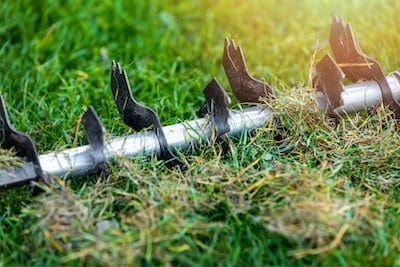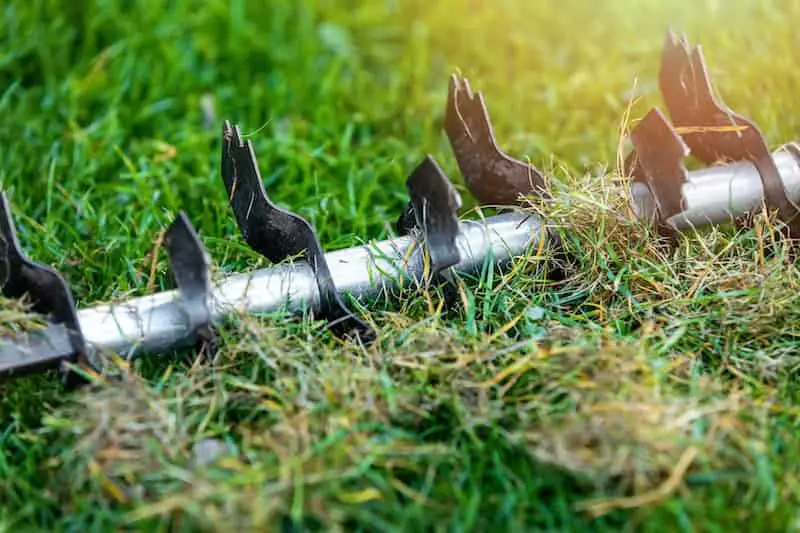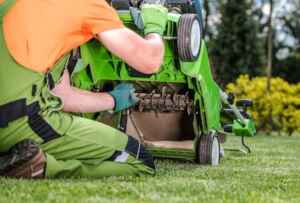Differences Between Lawn Dethatching & Aerating
When your lawn is overgrown and you want to return it to its green glory, two methods can be used. Dethatching, the process of removing thatch from lawns, and aerating, the process of opening up the lawn’s soil by punching holes in it with a machine or hand tool. Both dethatching and aerating have their benefits but may not always be necessary for your lawn.
So, what is better for your lawn: dethatching or aerating? There are benefits to both lawn dethatching and aerating. The method that will be best for your lawn will ultimately depend on the condition of your grass. Dethatching is best for lawns that have been overrun with decomposing clippings. Aerating, on the other hand, is best for a lawn that no longer receives the air circulation it needs to grow.
In this post, we will share some reasons why one might choose dethatching or aerating for their lawn needs as well as tips and tricks on how to revive your lawn once again!
What is Lawn Dethatching?
Dethatching is the process of relieving the lawn of its thatch, or dead and decomposing clippings. Thatch is a layer on top of the lawn’s roots. It forms when grass grows at an excessive rate and does not get cut often enough to remove all the old blades. This can lead to moss growth. It can also cause increased compaction in your lawn’s soil due to a lack of airflow between roots.
Dethatching removes this buildup so your lawn can breathe again by removing excess materials from above ground level. This allows more access for water and nutrients to reach plant roots below ground level. It also prevents mud accumulation during rains.
Dethatching prevents overcrowding and increases airflow between leaves so oxygen reaches deeper levels of the lawn. It is a good option for lawns that have been overrun by old grass blades and want to get rid of any moss growth.
What is Lawn Aerating?
Aerating helps increase air circulation between lawn roots which can lead to better root development along with healthier foliage and thicker blades of grass. Grass plants develop less chlorophyll when they do not get enough oxygen due to a lack of aeration resulting in yellowing leaves.
A lawn with rotting clippings will need frequent aeration to make sure it doesn’t collect too much decomposing material since this could lead to other types of lawn care problems such as bugs, weeds, fungus – all things you don’t want!
Lawns that have had their core disrupted by construction or poor management will require more frequent lawn aerating to maintain a healthy lawn environment.
Lawn aerating opens up areas in your lawn where air circulates through freely – providing oxygenation for lawn roots below ground level. A lawn that has been aerated before may not need it again for up to three years, depending on conditions and usage of the lawn.
Benefits of Lawn Dethatching vs. Lawn Aerating
The benefits of lawn dethatching are different from the benefits of lawn aerating as well. This is because they work with different processes. Dethatching removes dead material from atop your grass blades. Lawn aeration, on the other hand, opens air pockets so oxygen can reach plant roots deeper down beneath the surface level.
This is beneficial for many reasons! For one, the soil becomes less compacted when there’s an increased circulation of air. This is why lawns that are aerated will need less watering. Following aerating, the lawn maintains better water retention due to more exposure to soil and roots. This is especially true in periods of drought.
Another benefit of lawn dethatching is moss control! Dead plants or decaying blades can create an environment for moss growth when it starts decomposing on top of your lawn instead of living plants below ground level. Removing this layer provides an opportunity to apply necessary fertilizers as well as killing any pesky pests such as bugs, weeds, and fungus.
Dethatching vs. Aerating: Which Should I Choose?
 There are two ways you can go when it comes to dethatching or aerating your lawn – but which one should you use? It all depends on how severe the situation is! If you want a quick fix, we recommend trying out dethatching first since it’s less invasive than aeration. The dead material from old grass blades decomposes over time naturally. Because of this, there won’t be as much of a need for you to reseed afterward.
There are two ways you can go when it comes to dethatching or aerating your lawn – but which one should you use? It all depends on how severe the situation is! If you want a quick fix, we recommend trying out dethatching first since it’s less invasive than aeration. The dead material from old grass blades decomposes over time naturally. Because of this, there won’t be as much of a need for you to reseed afterward.
However, if your lawn is suffering from the effects of drought or construction and requires quicker results, we recommend other forms of aeration such as power raking. This removes layers upon layers with one pass so it gets the job done faster than dethatching.
You can’t go wrong with either option – just make sure that you stay consistent! If you are prone to forgetting things like watering your grass on time or you have animals walking through then dethatching may be more beneficial for general upkeep.
It is advised not to do lawn dethatching and lawn aerating on the same day. This is because the two processes work with different functions. You should also note that lawn aeration can cause your lawn surface level to be uneven. Because of this, you may want to consider watering or reseeding accordingly.
How to Dethatch Your Lawn
If you are looking for a way to get rid of moss growth or old grass blades in your lawn, we recommend that you try dethatching first. It is less disruptive than aeration, however it does not provide the same benefits.
The best time to dethatch is in early spring before grass blades start growing again – which isn’t until October. Dead material that was removed during this process can decompose naturally rather than piling on top of itself.
Lawns can be dethatched by:
- Using a garden rake or weed eater – this process requires more time because it needs to be done manually however, there’s no need for machinery with all its upkeep costs.
- Applying chemicals such as roundup or dyfencarb which will help kill off any weeds while also inhibiting them from growing afterward.
How to Aerate Your Lawn
If you want to improve the health of your lawn without disturbing surface level, we recommend aerating instead. Aeration is a more invasive process. However, it will help provide oxygen for plant roots and prevent other problems such as fungus or bugs.
Along with healthier foliage and thicker blades of grass, grass plants develop less chlorophyll when they do not get enough oxygen due to a lack of aeration resulting in yellowing leaves. Lawn aerating opens up areas where air circulates freely to help avoid this symptom.
Aerating your lawn regularly is recommended for those who live in drought-stricken areas or have been subjected to construction. Regular aeration will also ensure that the ground beneath surface level does not become compacted and reduce water retention.
Lawns can be aerated by:
- Power raking – this is a quicker form of aeration and requires machinery but will get the job done faster.
- Equipment such as core aerators or tine-type aerating tools are more time-consuming because they need to be taken out for each pass.
How Often Should You Aerate Your Lawn?
We recommend taking measures to aerate your lawn every four months, or at least twice per year. Aeration will help provide oxygen for plant roots. It will also help prevent fungus infestation which can occur when there is an excess of moisture in dry climates. In addition, it’s important to stay consistent with watering. This will prevent thirsty soil from compacting and depriving plants of vital nutrients.
When Should You Power Rake Instead of Aerating?
If you want to achieve a quick result for your lawn, we recommend power raking instead of aeration. Power raking is similar to dethatching and helps remove debris from the surface level. However, it can be done significantly faster than regular core-type aerators or tine-type instruments which are more time-consuming.
Maintaining a Healthy Lawn
In conclusion, it’s important to take into consideration how much time and money you’re willing to spend to maintain a healthy lawn environment.
Lawn aeration typically requires more maintenance than lawn dethatching because it involves opening air pockets while removing any rotting clippings. Lawn dethatching requires less maintenance in the long run. It is a good option for lawns that have been overrun with old grass blades or moss growth.
Finally, if you are still perplexed over whether aeration or dethatching is best for your lawn, it never hurts to consult a local professional or lawn care company. They will be able to assess your lawn and recommend a course of action that will provide you with the lawn of your dreams!
Related Questions
What do yellowing leaves on grass mean?
Yellowing leaves could signify a lack of oxygen in soil due to compacted ground. In other cases, it might mean that there’s not enough water. This means that plants cannot maintain chlorophyll levels as well as they should with normal hydration.
Can I use weed killers such as roundup during dethatching?
We don’t advise using any chemicals when dethatching your lawn as the process is already invasive enough. The best way to remove weeds without using chemicals would be through manual labor of weed pulling. Other types of organic herbicides are also good options.


